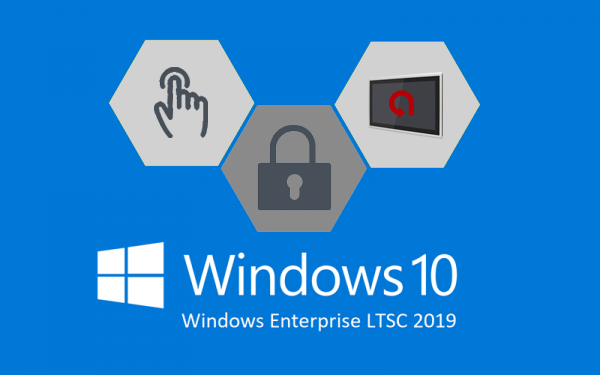
Assured Systems is a Microsoft Embedded Partner and we have access to the entire range of Microsoft Embedded development tools which allows us to create custom operating system images in-house. Our engineers are Microsoft trained and qualified to build images for Windows 7 Embedded, Windows 8 Embedded and Windows 10 IoT product families.
In July 2015, Microsoft released its first Long Term Service Branch, commonly known as LTSB. Initially, our customers didn’t understand what it was or why they would want to use it. Despite most OEMs feeling it was released too early and planned to wait for the next release, the product still became hugely popular.
Initially Microsoft planned to release a new LTSB version every two to three years, however, new updates were launched sooner than expected and the Windows 10 product quickly improved, having its first update released just a year later in 2016.
The LTSB acronym was later updated to LTSC as Microsoft decided to change “Servicing Branches” to “Servicing Channels”. Additionally, “Current Branch for Business” (CBB) changed to “Semi-Annual Channel” (SAC).
Moving forward, in March and September of each year, Microsoft’s new focus will also drive a new Windows 10 feature build every six months. The build versions will carry labels that correspond to the year and the month of the release. For example, Windows 10 ENT LTSC 2019 (1809).
What New Features Does 2019 LTSC Include for OEMs?
When Microsoft releases a new feature build, most of the new features are consumer focused. However, there are also some great IoT appliance features that will excite OEMs too.
Enhanced kiosk status reporting support via MDM (Mobile Device Management)
- Kiosks and digital signs are often placed in public places where issues are widely seen by people. With built-in status reporting, device management systems are automatically made aware of problems and can issue corrective actions like restarting the device or dispatching a service technician.
- Assigned access monitors the kiosk runtime state and allows the MDM server to query the latest status.
- Optionally, IT admin can opt-in to alerting mode, allowing an MDM to generate an alert to the MDM server when a kiosk runs into errors.
Simplified assigned access experience and ability to configure Edge kiosk settings
- Reducing deployment and management costs are key drivers of ROI. Windows 10 IoT Enterprise has improved features for configuring a kiosk experience via a new wizard in the Settings app, managing multi-app kiosks, and tailoring the Microsoft Edge browser experience for kiosk devices.
- Currently, you have the flexibility to configure Assigned Access using provisioning packages, the Settings app, and mobile device management systems. Now, a new set of Assigned Access APIs allows developers to configure Assigned Access programmatically from within their applications.
Ability to auto launch an app in the multi-app kiosk experience.
- Customers can now specify an auto-launch experience as part of the multi-app assigned access configuration, so the end user always has a default primary app experience.
- Added parameters to XML for multi-apps.
- You can control what the user sees from the moment the device is turned on until it’s powered off.
- Showing your logo instead of the Windows logo at boot, or auto-restart apps without error messages after an app crash, a system issue or a power interruption.
Consider Other Hardware Roadmaps When Prompting Microsoft Updates
It is important to remember that it isn’t just Microsoft’s roadmap you must consider when designing and forecasting the lifecycle of your device. You must also consider the hardware lifecycle, which means keeping an eye on Intel’s chipset roadmap.
In a last-minute change, Microsoft added the Intel 8th generation chipsets—such as Coffee Lake and Cannon Lake—to the support list for the 2016 LTSB edition.
|
Windows Edition |
Intel Processors |
Chipset |
|
Windows 7, Windows 8.1 |
Up to 6th Generation |
Skylake |
|
Windows 10 Enterprise LTSB 2015 |
Up to 6th Generation |
Skylake |
|
Windows 10 1511 |
Up to 7th Generation |
Kaby Lake |
|
Windows 10 Enterprise LTSB 2016 (1607) |
Up to 8th Generation |
Coffee Lake |
|
Windows 10 1703 |
Up to 8th Generation |
Coffee Lake |
|
Windows 10 1709 |
Up to 8th Generation |
Coffee Lake |
|
Windows 10 1803 |
Up to 8th Generation |
Coffee Lake |
|
Windows 10 Enterprise LTSC 2019 (1809) |
Up to 8th Generation |
Coffee Lake |
|
Windows 10 1809 |
Up to 8th Generation |
Coffee Lake |
In addition to chipsets, something as simple as your graphics card must also be considered. nVidia is currently not supporting the latest graphics chipsets on the older 2016 LTSB product, prompting several OEM customers to transition to 2019 versions.
Lifecycle and support are the main reasons an OEM would want the new the 2019 LTSC product. Not only does it extend the lifecycle by 2 additional years, but it opens the door to newer chipsets that will extend your hardware lifecycle. It is certainly the first option for an OEM’s new project.
Windows XP and Windows 7 Products Ending Support Soon
If you are still running any of the products listed below, start testing your platform on Windows 10 IoT Enterprise and 2019 LTSC now. It will be the product to use.
|
Microsoft Product |
End of Support |
End of Life |
|
Window XP WES |
8th January 2019 |
8th January 2024 |
|
Windows XP POS |
9th April 2019 |
11th February 2024 |
|
Windows 7 FES |
14th January 2020 |
30th September 2024 |
|
Windows 7 WES |
13th October 2020 |
27th July 2025 |
|
Windows 7 POS |
12th October 2021 |
10th September 2026 |










